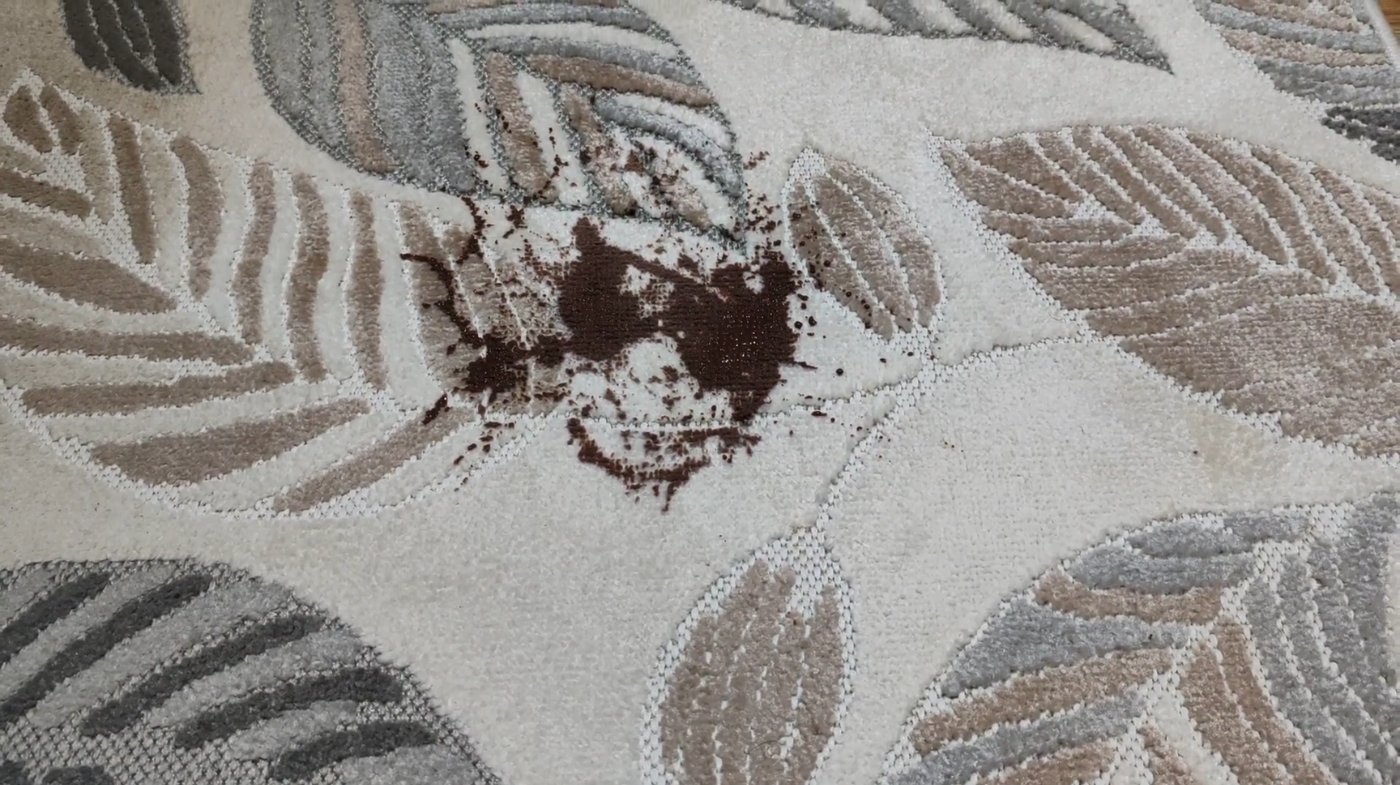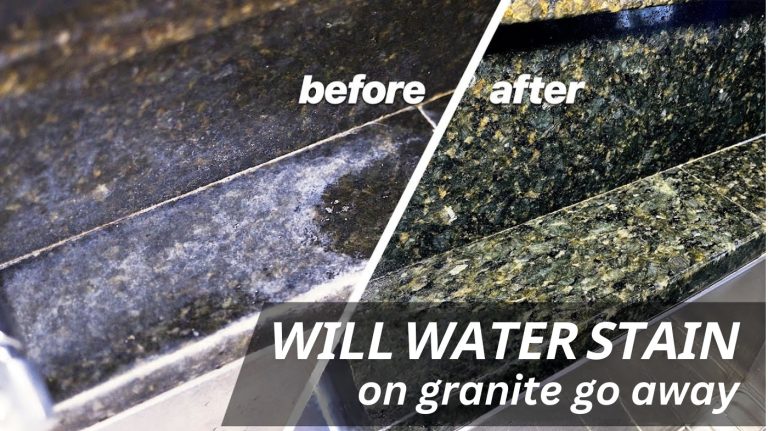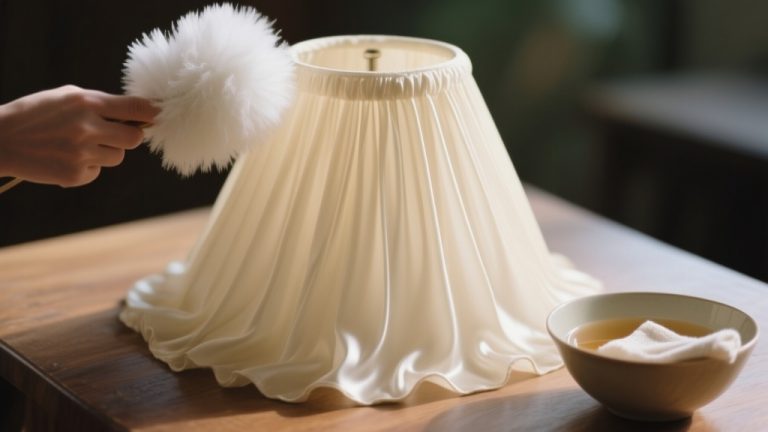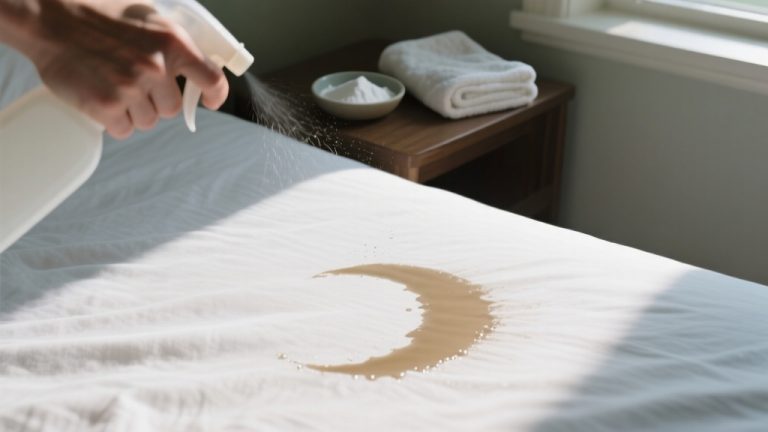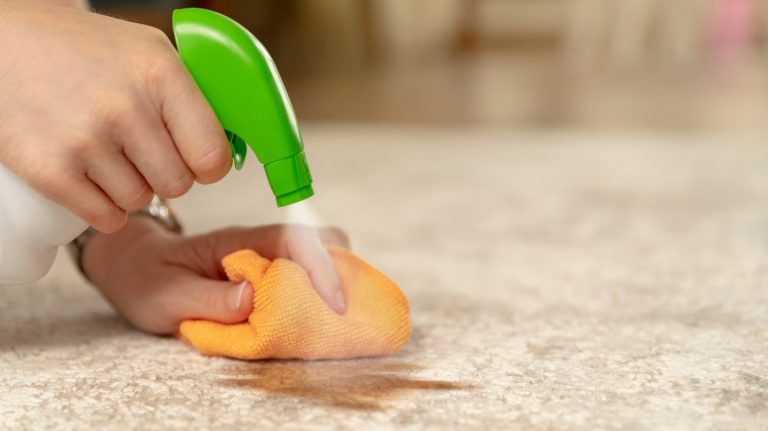How to Get Chocolate Milk Stain Out? Fast and Easy Tips
To get chocolate milk stains out, act quickly by blotting excess liquid gently without rubbing. Rinse the fabric with cool water, avoid hot water, as it sets stains.
Apply an enzyme-based stain remover or a mixture of dish detergent and cold water, letting it sit about 15 minutes before rinsing thoroughly. Air dry the fabric to prevent permanent marks.
For stubborn stains or delicate fabrics, specialized care is key. Keep following to discover tailored methods and prevention tips.
Key Takeaways
- Immediately blot excess chocolate milk with a clean cloth without rubbing to avoid spreading the stain.
- Rinse the stained area with cold water to prevent the stain from setting; avoid hot water.
- Soak the fabric in cold water for 10-15 minutes and apply a liquid detergent or enzyme-based stain remover.
- Let the pre-treatment sit for 15 minutes, then wash according to the fabric care label instructions using a recommended detergent.
- Air dry the item away from heat to avoid permanent stain setting and repeat treatment if necessary for stubborn stains.
Immediate Steps to Take After a Spill
When chocolate milk spills, act quickly to prevent the stain from setting. Below are the crucial steps to tackle the mess:
Act Quickly
Although spills happen unexpectedly, acting immediately can prevent chocolate milk stains from setting permanently.
First, carefully scrape off any excess chocolate with a blunt object like a credit card to avoid spreading the stain. Avoid rubbing or touching the area, as this only makes the stain worse.
Next, gently blot the stain with a clean cloth or paper towel to absorb liquid without pushing it deeper. Keep the stained area away from heat sources to prevent setting.
Maintaining moisture on the stain is essential, so avoid letting it dry out. Because chocolate milk contains both protein and oil components, cold water is critical to prevent the stain from setting in.
Use Cool Water
If you want to stop a chocolate milk stain from setting, immediately rinse the affected area with cool water.
Cool water prevents the stain from embedding into the fabric and loosens chocolate residue effectively. It’s safe for all fabrics, including delicate ones, since it avoids damage or discoloration that hot water might cause.
Rinsing with cool water also reduces the unpleasant odor of milk-based stains. For best results, soak the garment in cold water for 10-15 minutes, gently rubbing the stained area intermittently to dislodge the chocolate.
Cold water prevents chocolate fats from solidifying, ensuring uniform treatment and enhancing enzyme-based stain removers’ effectiveness.
Acting promptly with cool water is essential to simplifying and improving the overall stain removal process. Treat stains while they are fresh for easier removal and the best outcomes.
Gently Remove Excess
Start by gently scraping off any excess chocolate from the fabric using a blunt tool like the back of a spoon. Avoid rubbing, as this spreads the stain and complicates removal. Always use cold water to rinse the area after scraping to prevent the stain from setting.
Handle delicate fabrics with care to prevent damage during this step. Act quickly to increase your chances of fully removing the stain.
Check for any accessories or trims that might be affected and take precautions to protect them.
Step-by-Step Stain Removal Process
To remove chocolate milk stains effectively, follow a clear, step-by-step process that begins with preparation.
First, blot excess milk gently with a cloth to avoid spreading. Soak the stain in cold water for 10-15 minutes, rubbing lightly to loosen it. Avoid using warm water to prevent the stain from setting deeper into the fabric.
Next, apply a pre-treatment solution—choose mild detergent, a vinegar-water mix, or an eco-friendly stain remover bar—and let it sit for about 15 minutes.
Rinse thoroughly with cold water, then wash according to the garment’s care label, always using cold water to prevent setting the stain.
Air dry the item; avoid heat, which can fix stains permanently. If the stain persists, repeat pre-treatment and washing.
For old stains, soak overnight and consider multiple treatments before seeking professional cleaning.
Handling Different Fabric Types
When treating chocolate milk stains on delicate fabrics, always test for colorfastness before applying any cleaner. Use gentle detergents and avoid harsh chemicals to prevent damage.
Delicate Fabrics Care
Although delicate fabrics demand extra care, you can effectively treat chocolate milk stains by using cold water and gentle detergents tailored to their specific fibers.
Always act quickly to prevent the stain from setting. Immediate washing prevents the stain from setting, which is crucial for better results. Before applying any cleaner, perform a spot test on an inconspicuous area to ascertain the fabric won’t get damaged. Silk and wool require special attention; consider professional cleaning if unsure.
For other delicate fabrics like rayon or bamboo, stick to mild, enzyme-based detergents and avoid hot water.
- Rinse stains immediately with cold water to prevent setting.
- Use gentle, eco-friendly detergents designed for delicate fibers.
- Air dry after treatment to avoid heat damage.
Colorfastness Testing
Three key aspects define effective colorfastness testing: the type of fabric, the testing method, and the conditions applied.
You must tailor tests to fabric characteristics—upholstery demands high rub fastness (over 500 cycles), while t-shirt knits tolerate lower levels (200–300 cycles). Delicate fabrics need gentler testing to prevent damage, and woven fabric testing varies with weave density. Synthetic fibers often respond differently than natural ones, requiring adjusted protocols.
Use standard methods like AATCC 16 for lightfastness and ISO 105 E01 for water fastness. Employ tools such as the crockmeter for rub fastness and the gray scale to rate results.
Professional Cleaning Options
Since chocolate stains vary widely across fabric types, professional cleaning approaches must adapt accordingly.
Treat delicates with cool water and mild detergents, avoiding bleach to prevent damage. For cotton, soak in cold water and apply dish soap solutions before thorough rinsing. Remember that milk contains colloids and proteins, which can affect how stains set in different materials.
Wool and natural fibers respond best to gentle blotting with dish soap and vinegar rinses, while synthetic fabrics require immediate cold water rinsing and eco-friendly stain removers.
Always avoid heat to prevent setting stains.
Key professional cleaning tips:
- Use cool or cold water to prevent stain setting across all fabrics.
- Apply fabric-specific stain removers or mild detergents tailored to the material.
- Blot stains gently rather than rubbing to avoid spreading or embedding the stain.
Dealing With Persistent Stains and Odors
When chocolate milk stains refuse to budge, you need targeted strategies to tackle both the residue and any lingering odors. Start by gently scraping off excess residue and rinsing with cold water to prevent setting.
Apply an enzyme-based remover, let it sit, then scrub softly. For odors, soak in baking soda solution and add white vinegar to the rinse cycle. Avoid heat drying until stains vanish.
| Action Step | Purpose | Tips |
|---|---|---|
| Enzyme-based remover | Breaks down proteins/fats | Let sit 5–30 mins |
| Baking soda soak | Neutralizes odors | Soak before washing |
| Soft brush scrubbing | Targets stubborn stains | Use gently to avoid fabric damage |
Repeat if needed or seek professional cleaning for delicate fabrics.
Tips to Prevent Future Chocolate Milk Stains
Persistent chocolate milk stains can be frustrating to remove, but preventing them from happening in the first place saves time and effort.
You can minimize spills and stains by adopting simple habits and protective measures. Handle chocolate milk carefully, especially with children, and use spill-proof containers. Protect clothing with aprons or stain-resistant fabrics. Educate children on proper drinking etiquette to reduce accidents.
- Use spill-proof containers and place mats or trays to catch drips.
- Wear aprons or stain-resistant clothes and keep stain remover handy.
- Teach children to hold cups securely and clean spills immediately.
Frequently Asked Questions
Can Chocolate Milk Stains Be Removed From Upholstery or Carpets?
Yes, you can remove chocolate milk stains from upholstery or carpets if you act quickly. Start by blotting excess liquid without rubbing to avoid spreading. Use a mixture of lukewarm water and gentle detergent or an enzyme cleaner to break down milk proteins.
For stubborn stains, apply a specialized carpet cleaner. Remember to rinse with cold water and sprinkle baking soda to neutralize odors. If stains persist, consider professional cleaning.
Is It Safe to Use Bleach on White Clothes With Chocolate Milk Stains?
You can safely use bleach on white clothes with chocolate milk stains if the fabric is bleach-safe. Use Clorox Disinfecting Bleach, diluted at one teaspoon per cup of water, to avoid damage. Always spot test on a hidden area first to guarantee no discoloration or weakening occurs.
Avoid bleach on delicate fabrics like silk or wool. Follow garment care labels and rinse thoroughly after treatment for best results.
How Do Chocolate Milk Stains Affect Delicate Fabrics Like Silk or Wool?
Chocolate milk stains may seem harmless, but on delicate fabrics like silk or wool, they’re a hidden threat. You’ll find their protein and oil components cling tightly, risking permanent marks. These fabrics react sensitively, so heat or harsh chemicals only worsen damage.
You must act swiftly and gently, using cold water and mild solutions, or better yet, trust professionals. Otherwise, you risk ruining your precious garments beyond repair.
Can Professional Dry Cleaners Always Remove Chocolate Milk Stains Completely?
You can’t always expect professional dry cleaners to remove chocolate milk stains completely.
While they use powerful solvents and pre-treatment techniques, the fat and protein in chocolate milk can be stubborn, especially if the stain has set or been exposed to heat.
Fresh stains respond best, but delicate fabrics or old stains may still show residual marks. Professionals improve chances but can’t guarantee perfect results every time.
Are There Natural or Homemade Remedies for Chocolate Milk Stain Removal?
You don’t need a magic wand to erase chocolate milk stains! Natural remedies like white vinegar diluted with water and baking soda can work wonders. For fabrics, try a mix of dish soap and cold water, or a gentle soak before washing.
On carpets, baking soda paste absorbs stains overnight. Hydrogen peroxide helps but be cautious—it might bleach. These homemade tricks tackle stains effectively without harsh chemicals, saving your clothes and surfaces.
Say Goodbye to Stains: Keep Fabrics Fresh and Spotless
Picture a fresh, clean fabric free of chocolate milk’s stubborn marks. By acting quickly, using the right products, and following each step carefully, you can restore your clothes to their original state.
Different fabrics need gentle care, but persistence pays off. With these strategies, you’ll not only erase stains but keep odors at bay. Next time, you’ll face spills confidently, turning messy moments into nothing more than a distant memory.

